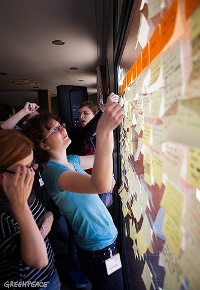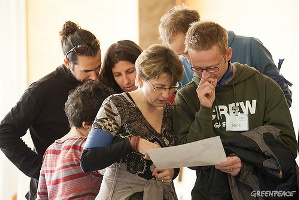There are many things I could write about after attending Greenpeace’s Digital Mobilisation Skillshare: the smart, passionate people I met (I’ve already written about some of them here), the lively debates on how to mobilise more people to change the world, or the social energy of Spain, where on the first evening I witnessed protests of a failing economy and government corruption.
But after reflecting on the event and my experience, what struck me most was the way the conference was a direct reflection of what it wanted to create in the world.
The Greenpeace Digital Mobilisation Skillshare aims to help Greenpeace staff members build campaigns that enable and unleash the potential of its more than 20 million members across the globe.
|
Image

|
| Photo credit: Ibraheem Mohammed |
No small challenge. And when confronted with this complex problem, awash with ambiguity and a rapidly changing sector, the event could have looked outside to the “experts” for answers, featuring a steady stream of keynotes, best practice sharing and what’s worked for others.
Instead, the event made the 140 participants from 50 countries the “collective” keynotes, inviting every participant to take part in designing and facilitating sessions on mobilisation.
Five guests or “experts” did present, and their insights from maximizing the use of mobile to daily campaigning were greatly appreciated, but these sessions took place at the same time as sessions held by multiple Greenpeace staff members.
Typically, 12-15 different sessions were running concurrently creating intimate discussions that participants chose to attend.
Open space technology, which is the approach taken by the Digital Mobilisation Skillshare is not new, but I can’t think of a more appropriate model for this event. When exploring how to get citizens engaged and acting on what matters, the conference was a model; it was a people-powered event.
Participants walked through the engagement process. That is, loosening the reins, and empowering the people who will have to live with the decisions made to determine what’s meaningful, how they want to act, what they need to learn, and to trust that process.
Such an approach is not easy for organizers or participants. As an organization you have to let go of controlling the outcomes and instead set the vision and hold the space, a space that invites leadership, inclusion and possibility.
|
Image

|
| Photo credit: Ibraheem Mohammed |
As a participant, you have to completely reframe your expectations. You are no longer a passive recipient of information. You are collaborating, exploring and ideally pushing past a fear of failure to truly embrace new ideas and opportunity.
Holding a traditional conference with expectations of teacher and student is much easier, but as our friend and author Peter Block writes, in doing so we disempower the collective. We have all been mentored and coached, and most of us have mentored and coached others. If we are waiting for more knowledge, more skills, more support from the world around us, we’re waiting too long.
It’s time to act like we know, and organize with others who share our passion.
Kudos to the Digital Mobilisation Lab for demonstrating this so beautifully.
Axiom News provides Stakeholder News to Greenpeace Digital Mobilisation Lab.






Comments
thanks camille
great post
glad you were there!